In preparation for Worlds, I spent a lot of time playing with Michael Hamilton's US Nationals Iyslander build and found that it had surprising similarities to my Rhinar deck (you can read more about Brute's best qualities here). Parallels can be found in the underlying principles in deck construction and the ways in which turns are structured. To be clear, my list is not on the same level as Hamilton's, but the synchronicity here indicates that a very effective paradigm exists – and it's something that can be applied beyond the two heroes. For lack of a better name, that paradigm is Value. To best explain it, I want to walk you through how I understand the game as a Rhinar player, then compare that to Hamilton's Iyslander list.
Michael Hamilton wrote a full explanation of his Wounded Bull Iyslander in a Pro Series piece for us back in October. He also shared his theory on card evaluation back in April- which foreshadowed the role of Wounded Bull in value-focused decks!
The evidence to support my claims is purely experiential, so let me tell you a story...
The Vancouver FaB community is not large, but it's dense with strong players. Notably, it's Yuki's stomping ground- but four of us took Top 8 at Canadian Nationals. These people beat me up for the better part of the year. The lessons I've learned from those games have become guiding principles.
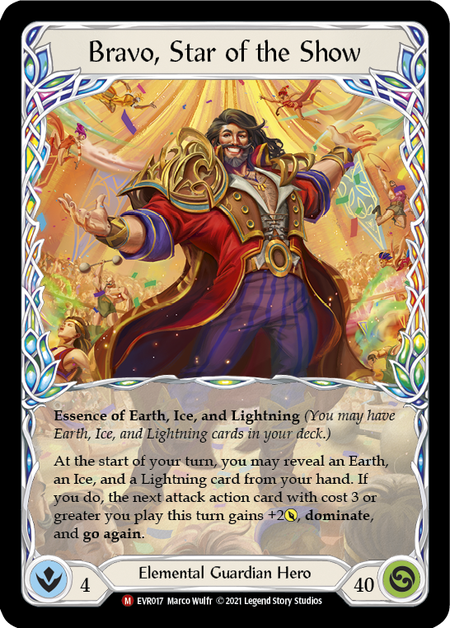
Moreover, I basically learned the game in the Starvo meta, and during that I made some observations. After weeks and weeks of fused Crippling Crushes and Oaken Olds, I realized that Flesh and Blood is primarily an efficiency problem, and that every deck has a handful of turns that break the fundamental economy of the game. These are stitched together by many fair turns that, at best, stretch the limits.
Starvo wasn't the best deck because every turn was superior – it was that he had twice as many broken turns by having access to both Crippling Crush and Oaken Old. Everything in between was still, essentially, fair. If I could figure out how to make those in-between turns as effective as possible, I could make up the ground I inevitably lost whenever a massive dominated attack came knocking.
The Theory
There was an economy underlying the game. For almost every card in the game, resources directly translate into damage. Resources not spent in a turn is damage wasted. Why pitch a yellow to attack for 6, when you could pitch a blue to attack for 7? Both plays require two cards, but only one of them trades favorably with two cards that block for 3.
This could be the foundation of a strategy, but how demanding were the situations required to execute it effectively? You still need to be able to support your broken turns.
Working within those constraints, I started looking very critically at my cards. Which ones were more effective than a blank card that blocked 3? I started looking at turn cycles now in terms of how much damage I was threatening, how much damage I was blocking, and how much damage I cost my opponent by making them block. I began to see every part of the game as a damage transaction.
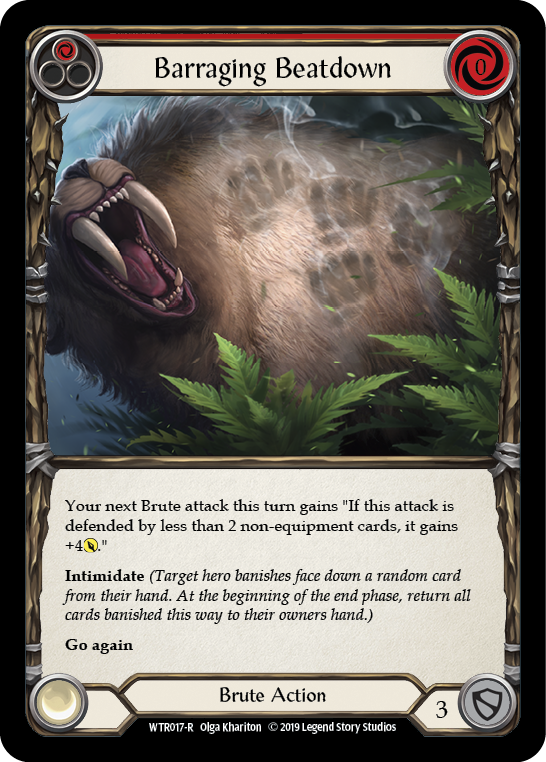
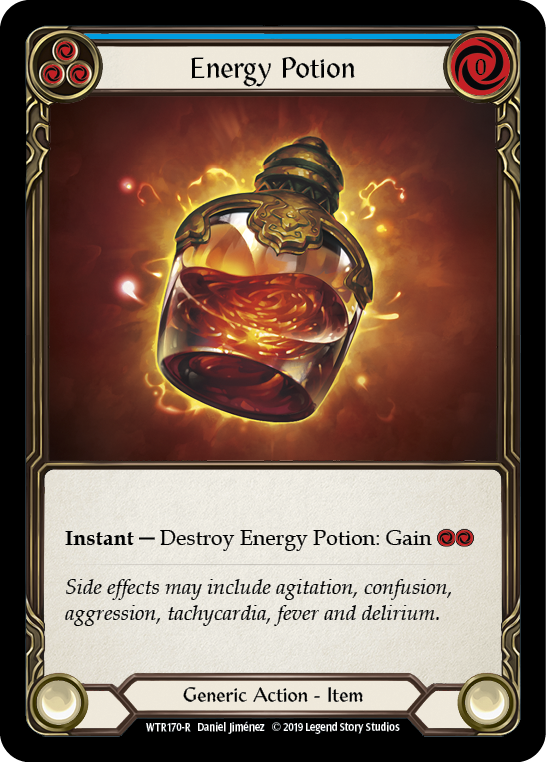
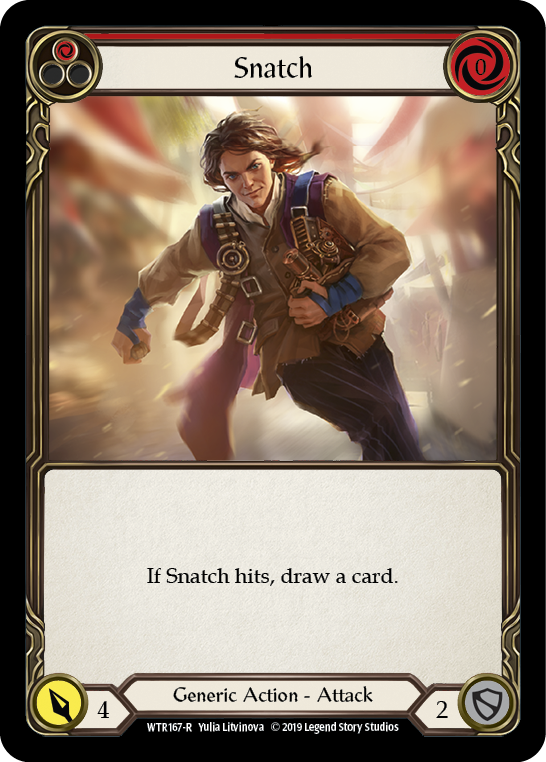
If a Snatch hits, the card it draws represents around 3 or 4 damage, if it can be played or kept in the arsenal. An Energy Potion means, in the future, you can play a card that costs 2 more resources as opposed to blocking with it, dealing 2 more damage. A red Barraging Beatdown and a club swing deals 0 damage if it's blocked by any two cards, but if those two cards reduced my opponents damage output from 16 to 8, it might as well have been a block for 8, which I was starting to realize was just as good as damage dealt.
Preventing damage this turn allows you to take more damage when your future broken turn demands that you shouldn't block. However, there is a big asterisk on the statement “damage prevented is as good as damage dealt” – it's only true if the damage you deal is sufficient to win the game through blocking. That being said, the majority of the Starvo meta was not a blocking meta, so it was not a problem I was aware of at the time.
My strategy was as follows:
- Every red pitch card in the deck needs to represent a play pattern that stretches the limits of the game economy.
- Additionally enough of them need to block 3 such that I can always block and attack in a combination where the sum of those values exceeds my opponent's turns on average.
Putting my principles into practice paid off surprisingly well. My results improved dramatically, and I was getting Top 4 finishes alongside all the local killers who used to run me over. I was going blow for blow with Starvo because most of my turns were slightly more efficient.
Eventually, just before rotating, Starvo lists approached a solved state and sadly I was no longer winning those games. It wasn't because the broken turns were any stronger though – it was that the in-between turns were finally too efficient.
Eventually, Starvo, Prism, and Chane rotated out, and the meta I learned the game on was essentially gone. It was at this point where I was confronted with the issues of my “damage prevented is as good as damage dealt” theory – I was fatiguing out, because defensive decks were now popular. My turns that were amazing on paper - the ones where I got to block 6 damage and attack for 11 off 4-card hands - were a joke to decks that blocked 12 damage in a turn without blinking. I realized that the damage you deal needs to account for defense. Either it comes in massive quantities all at once, or it can't be blocked effectively.
After a bit of polish, the deck that emerged performed excellently while embodying everything I had learned over the year.
- Cards and resources usually buy damage or prevent it at rates that scale linearly. Every point earned beyond that generates value.
- Damage prevented is essentially equivalent to damage dealt.
- Decks need broken turns in order to win the game.
- There must be damage that can either overwhelm or avoid defense before fatiguing out.
- The requirements of your fair turns cannot overly compromise your broken turns.
How Michael Hamilton is Living This Theory
Not all of these points are directly related to the Value Paradigm, but they all inform a winning game plan surrounding value. If we were to map these principles directly onto Hamilton's list, we find that all of them are present.
1. Cards and resources usually buy damage or prevent it at rates that scale linearly. Every point earned beyond that generates value.
This is the thesis statement of the Value Paradigm. Every. Point. Matters. If there are extra points of damage we can earn over our opponents with tight play and informed deck building decisions, we take them.
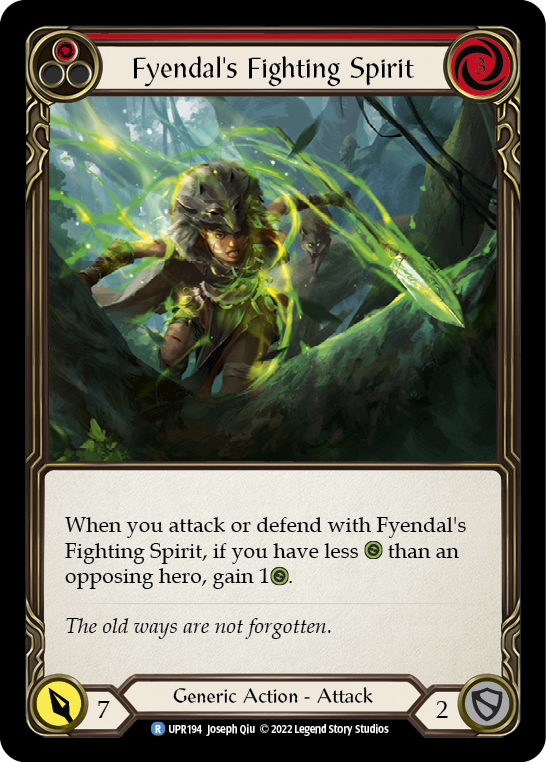
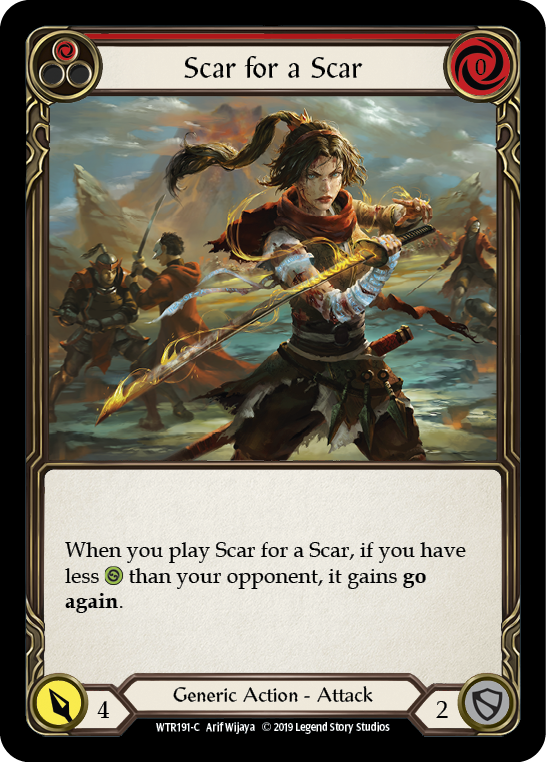
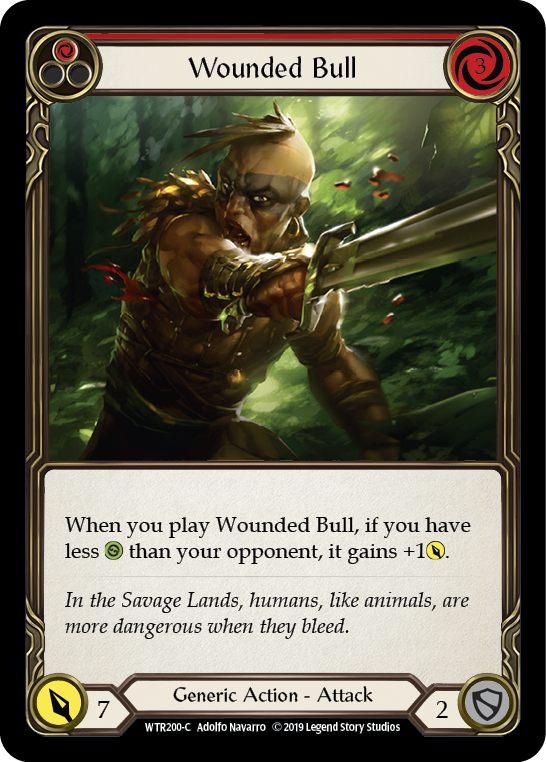
Obvious exemplars of this are Wounded Bull and Fyendal's Fighting Spirit. By the game's economy, 3 resources should buy 7 damage, but these cards conditionally generate an extra point of value.
Somewhat less obvious is Scar for a Scar. Its conditional 'go again' doesn't explicitly add value, but consider what a card should be doing at its rate. Head Jab is the model for 0 cost unconditional 'go again'. Scar's conditional nature means that it gets away with being allocated an additional power. If meeting the condition is a given (and it almost always is when you're playing Iyslander), and you can leverage the extra action point (and you always can with a blue to pitch to Coronet Peak), then you are still generating a point of value.
Every hero has tools that allow them to pull ahead of the economy in unique ways, but having generic cards that also can do that, increases the “value density” further beyond what might be expected for a class that has to pay the “arcane tax”.
The “arcane tax” refers to the reduced power of arcane damage-dealing actions. For a variety of reasons, arcane damage sources deal 1 point less of damage across the board. Wounding Blow deals 4 damage for 0 resources? Aether Dart deals 3. Critical Strike deals 5 damage for 1 resource? Scalding Rain deals 4. By the principles of a value-based paradigm, this is disastrous. How can we win when most of our cards lose value to our opponents?
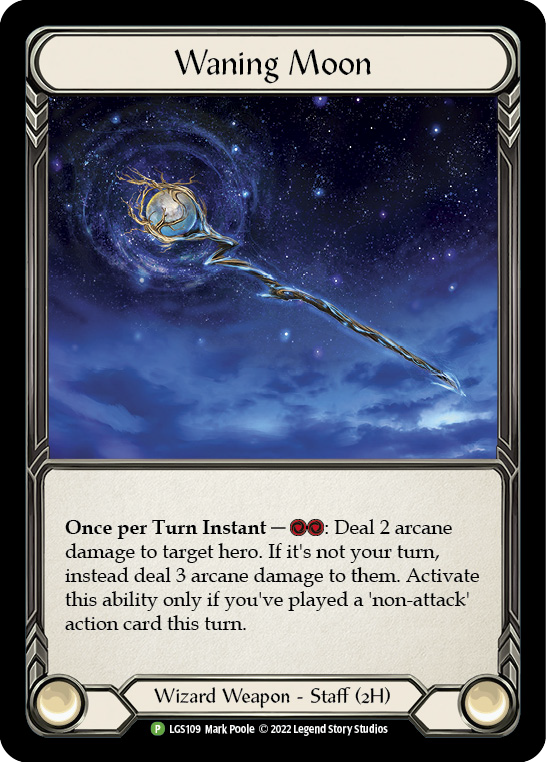
There is one exception to this: Waning Moon. On your opponent's turn, Waning Moon deals 3 damage for 2 resources. On paper this isn't terribly impressive – for 2 resources, Rhinar gets to swing his Romping Club for 4 damage. However, consider that Waning Moon doesn't require an action point – this puts it on par with Searing Emberblade, even through the “arcane tax”. Emberblade is a very strong weapon in its own right, so the comparison is favorable.
The drawback of Waning Moon in Iyslander is that we only get the excellent 3 damage if we activate it on the opponent's turn, and the only way to activate it then is to play a blue non-attack action from arsenal as an instant. Playing blue cards offensively is also generally poor value as they deal 2 damage less across the board compared to reds. This leads into Iyslander's frostbite generation and the next principle.
2. Damage prevented is essentially equivalent to damage dealt.
The idea here is that every damage you prevent now means that you need to block with fewer cards to withstand lethal damage in the future. If we blocked with our blue Wounding Blow on turn 1, that means we have 3 more life to work with on the last turn when we're deciding whether we want to block with a red Wounding Blow. Being able to attack with it means that our early decision earned us 2 extra damage in the long run.
Consider the last principle: that damage and resource cost increase at the same rate. In an ideal universe, having 1 less resource means you have to play a card that costs 1 less, dealing 1 less damage. Iyslander's frostbite generation means that our opponent is forced to deal less damage than what they could have. Sometimes they will have excess resources and won't be slowed down, but that just means that their turn was inefficient anyways and we still came out ahead. So in an ideal universe (for our opponent), a frostbite means they deal one less damage.
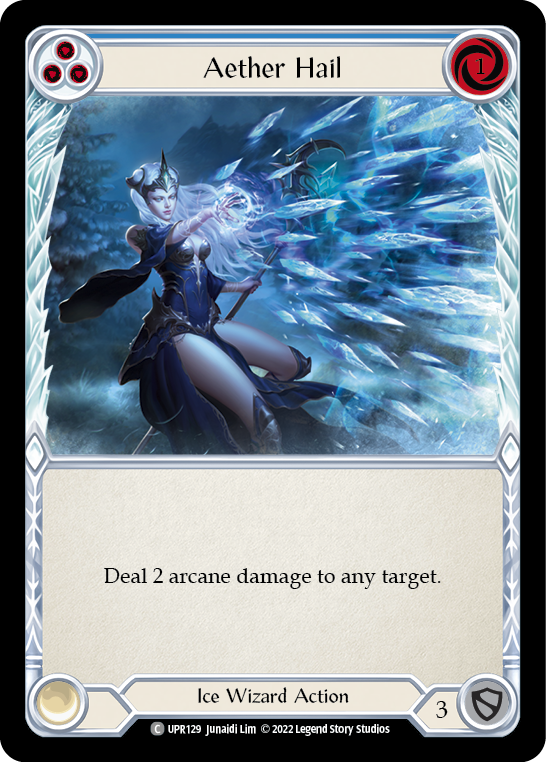
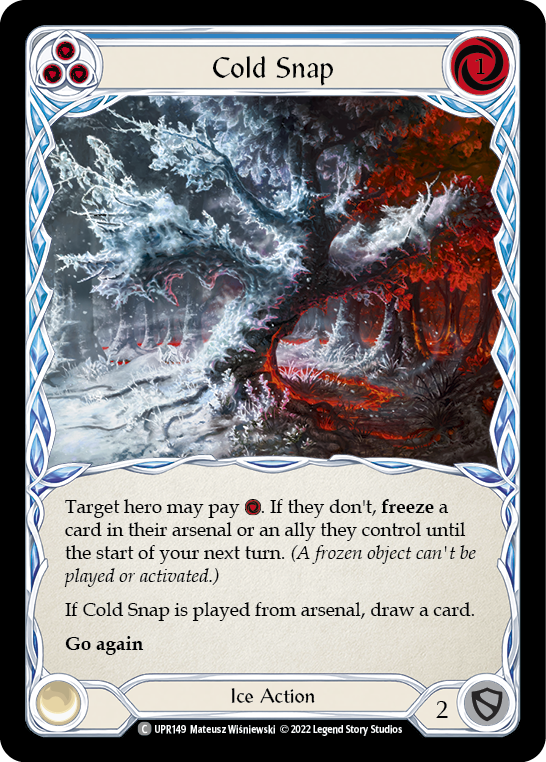
If we play blue Aether Hail as an instant on their turn, create a frostbite and activate Waning Moon, we dealt 5 damage and prevented 1 for 2 cards – all without expending our action point. Considering that our blues that block for 3 are doing the same work that red Head Jabs are doing while blocking for 2, we are satisfied with the rate we are getting. Cold Snap is even better. The fact that it replaces itself means that we essentially made a frostbite and activated Waning Moon for 3 damage off 1 blue pitch – a 4 point value swing. If they paid to keep their arsenal or ally unfrozen, it goes up to 5 – if a 0 cost card that attacked for 5 with unconditional go again ever got printed, there might be riots.
Now consider if things aren't ideal for our opponent. There comes a point in every game where a frostbite lands and your opponent's shoulders sag. This indicates that they don't have the pitch to cover it and they had to pitch something they would have rather attacked with. This represents a very significant value swing in our direction, by virtue of the damage prevented. While these points of value generated are essential to winning a game, turns that break the game economy wide open will swing the game right back the other direction. Naturally we need some of those for ourselves.
3. Decks need broken turns in order to win the game.
For most decks, broken turns are pretty straightforward. Bravo dominates a Crippling Crush, Fai resolves Art of War, Briar lands a Channel Mount Heroic. Iyslander however, has a toolbox of broken turns that are uniquely suited to each matchup. It doesn't always deal damage, but damage prevented is damage dealt later after all. A Hypothermia can easily prevent 12 damage against Dash. A triple Frost Hex combo can have an Oldhim dead at 20. Channel Lake Frigid slashes the damage our opponent gets to deal over multiple turns if we can keep it in play (and we should certainly do our best).
Regardless of what broken turns we need for the match up, we always have one more guaranteed. We throw our entire hand at our opponent and their life falls to the single digits while they take 2 cards into their own turn. We draw back up to 4 cards and get to use Storm Striders and Iyslander’s ability to throw another full hand at them when they can't defend themselves. We were able to compress 20 or more damage into our opponent's measly 4 cards. That we have no cards left for the next turn doesn't matter if we won the game.
4. There must be damage that can either overwhelm or avoid defense before fatiguing out.
This may seem like a continuation of the last principle, but it is equally important. Consider that you are against a very defensive Oldhim. You have gone through your entire deck and resolved every broken turn at your disposal and managed to bring him down to 1 life through his full blocks. If after that point you can't deal more than 12 damage in a single turn to get over his blocks, you will still lose the game.
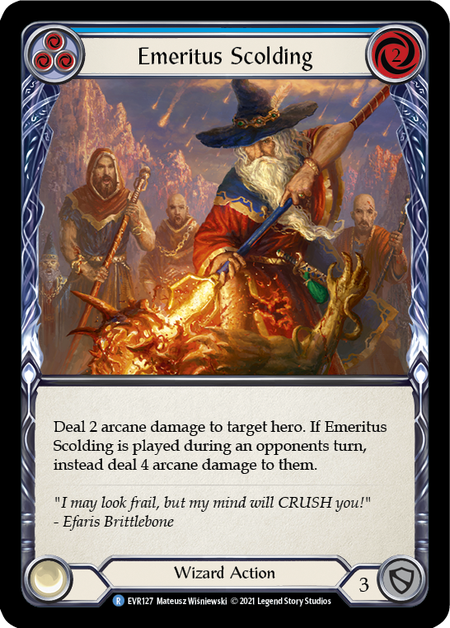
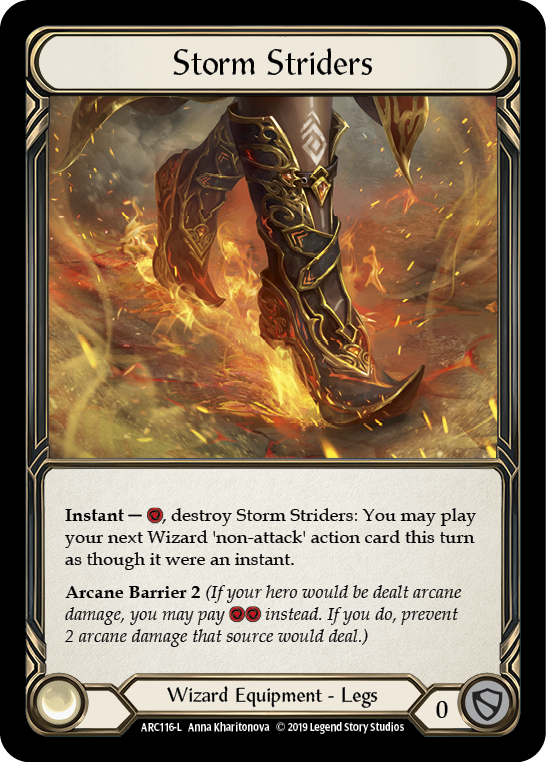
Naturally, Iyslander has the solution. By attacking on our turn with a big Wounded Bull and placing an Emeritus Scolding in arsenal, we force the defensive player to block into our very efficient attack. Then, after they let their defenses down while making their own attack, we get to slip in damage. Often this play pattern results in both parties trading similar amounts of damage, but that is to Iyslander's advantage. After all, if both parties are sitting at 5 life, only one of them can lose at instant speed and it's the poor sod without Storm Striders.
5. The requirements of your fair turns cannot overly compromise your broken turns.
There is a trap with regards to pursuing Value. If you get too greedy in your attempts to maximize fair turns, you ruin your chances of reaping the rewards of broken turns.
This is Iyslander’s strength that was always obvious, but it is just as well represented in Hamilton's list as anywhere else. The fact that she is so effective with blue cards means that she is incredibly consistent. She never lacks for pitch, and almost always gets to spend it well.
Hamilton's most obvious innovation here was simply allowing her to leverage her blues for attacks that ensure that she never falls behind in value. This almost never comes at the expense of being able to leave her opponents turn in shambles or overwhelm them with massive damage. Additionally, many of her cards block for 3 - meaning that even if we can't play them, we are still getting a fair rate for them on defense.
Closing Thoughts
The principles listed here aren't ironclad rules on how the game should be played, and they weren't produced by some billion dollar think-tank. It's merely a way of looking at the game that has yielded effective results. I've always believed that knowledge is meant to be shared, and if it is something that brought me success and is something I can shed light on for you, I think the game is better for it.
Hamilton's build of Iyslander is inspiring in its commitment to value and his Worlds win with it proves that it works. I think it's an amazing deck for learning how to understand turn cycles, as well as seeing how many small decisions can compound over a game to result in victory. The process is incredibly rewarding and I recommend trying it for yourself and seeing what Value can do for you.
Background music is Adventures by A Himitsu Acoustic Crossing by LesFM | Bachs Bouree In Celtic Minor; Adventure by Alexander Nakarada | Creative Commons — Attribution 3.0 Unported— CC BY 3.0 Creative Commons CC BY 4.0 | A Himitsu - Music released by Argofox | Music promoted by Chosic






